
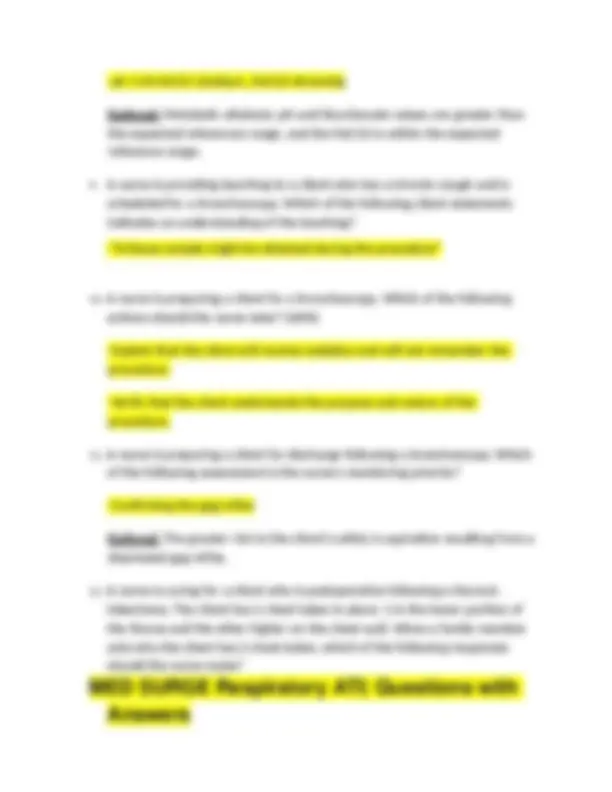
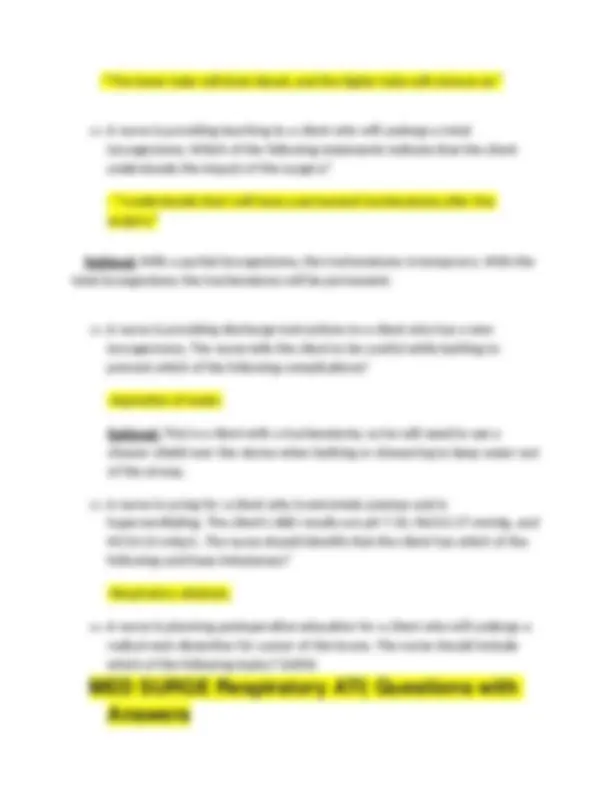
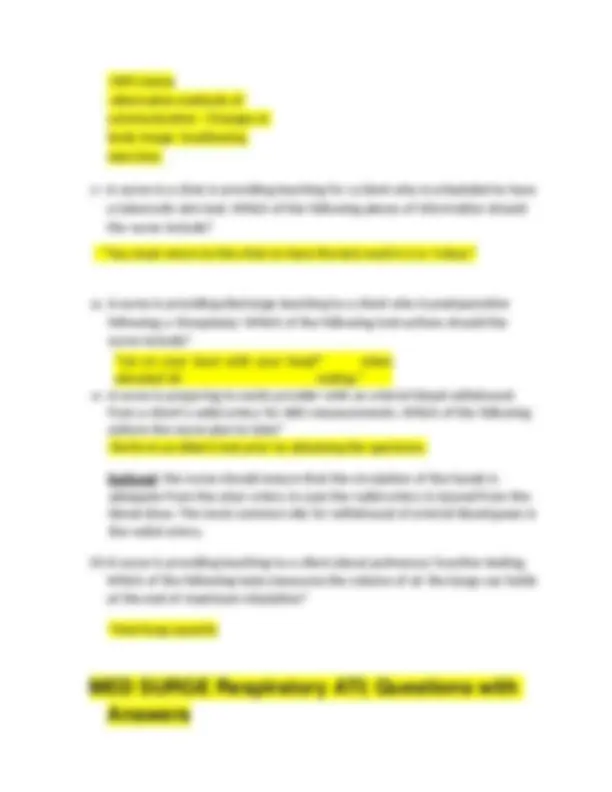
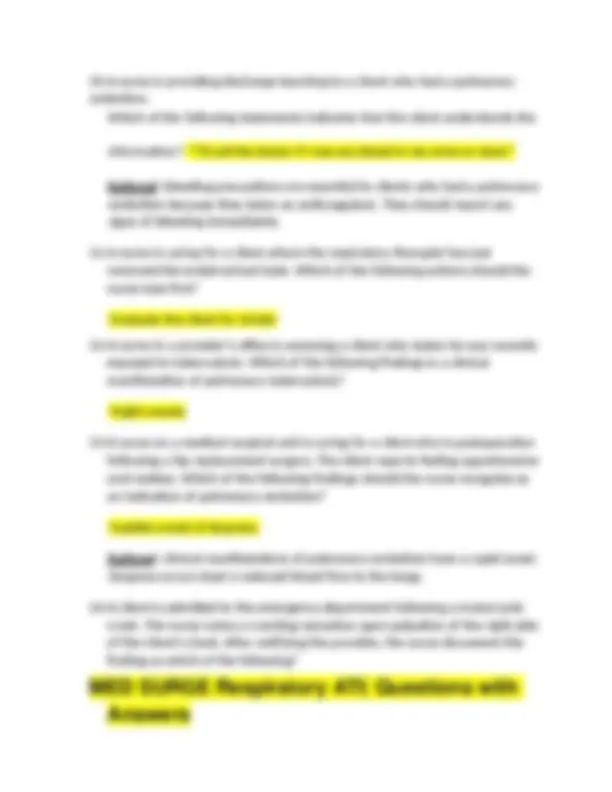
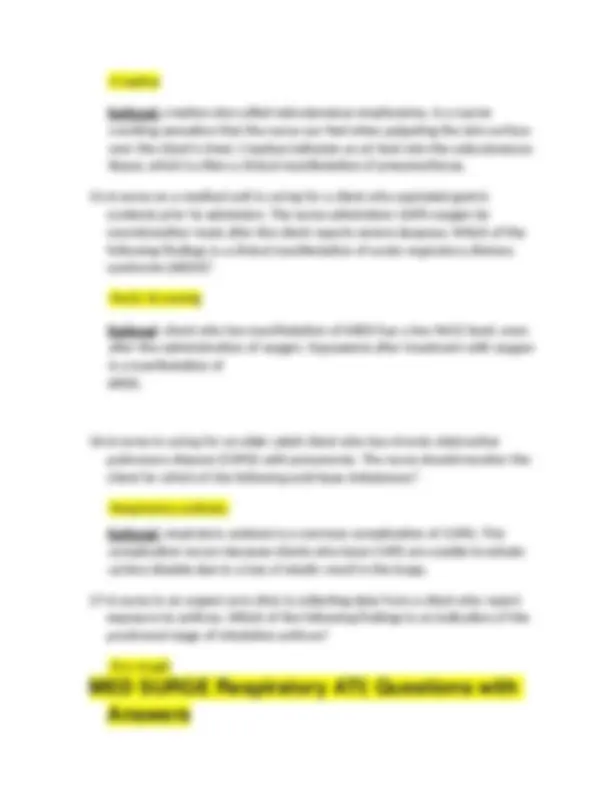
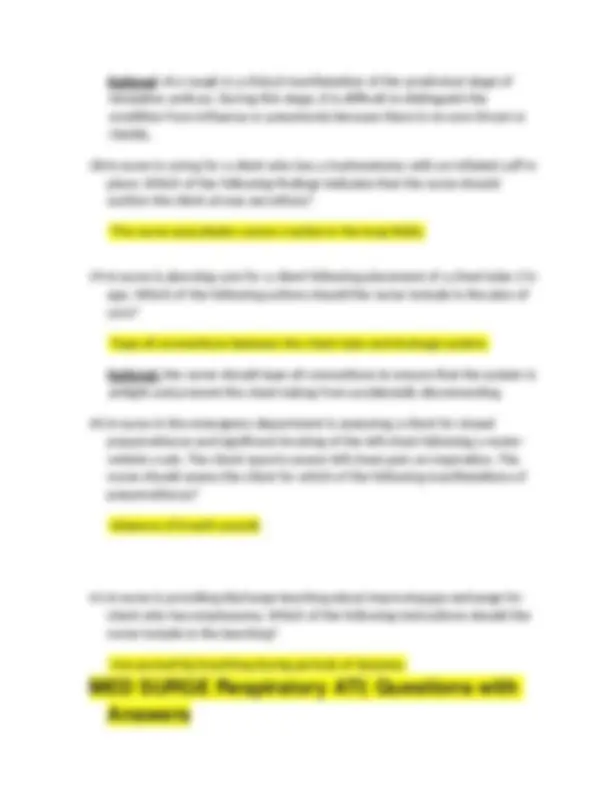
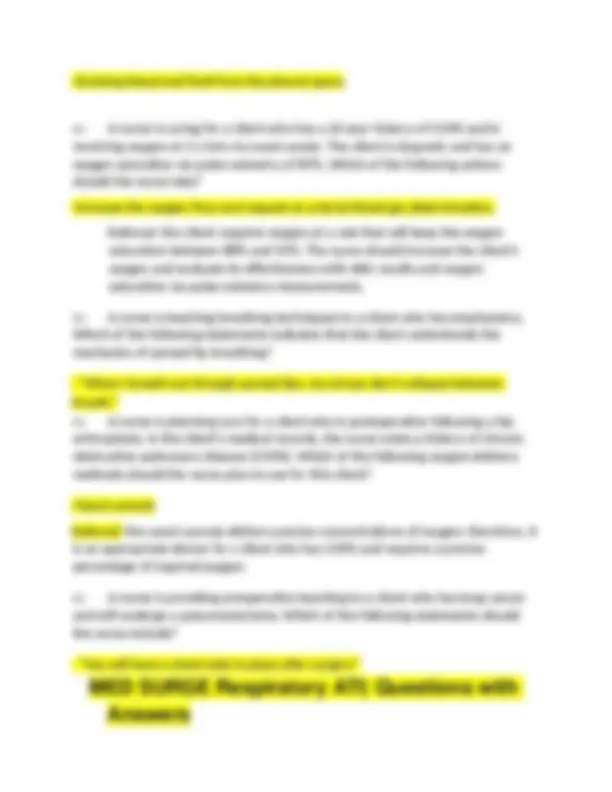
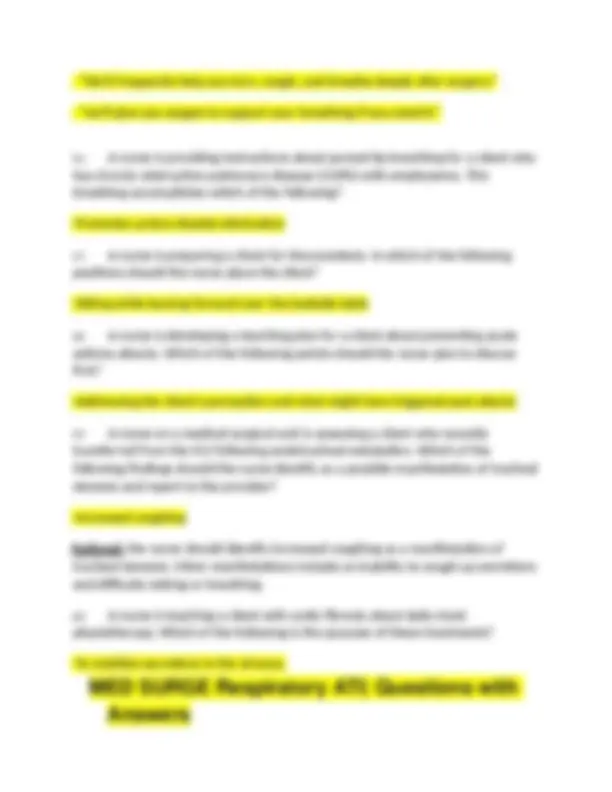
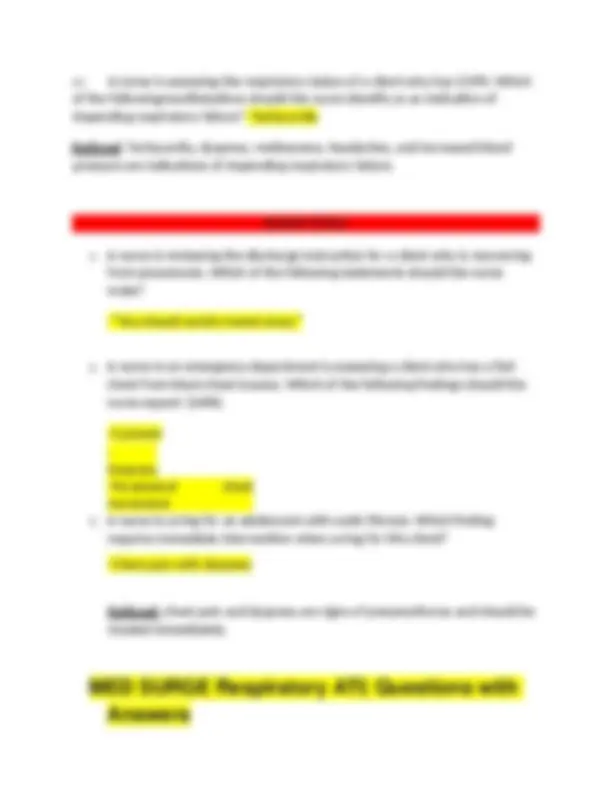
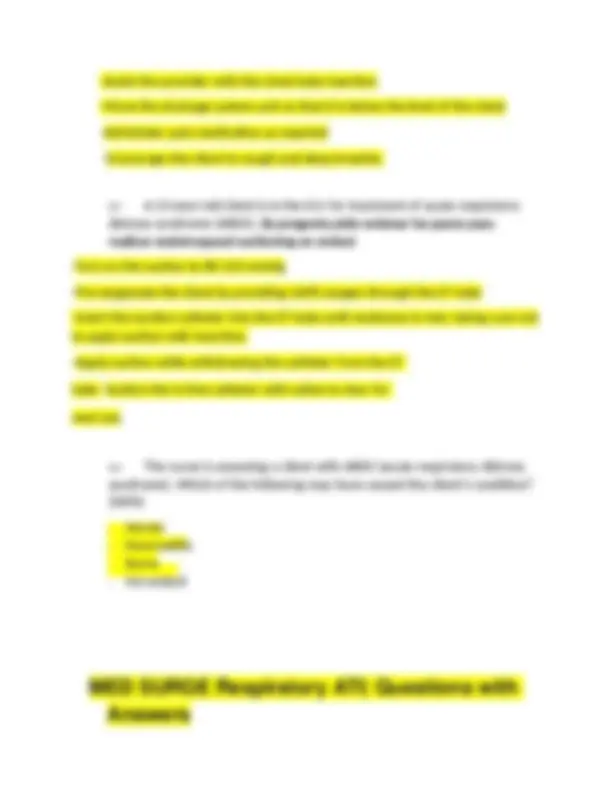
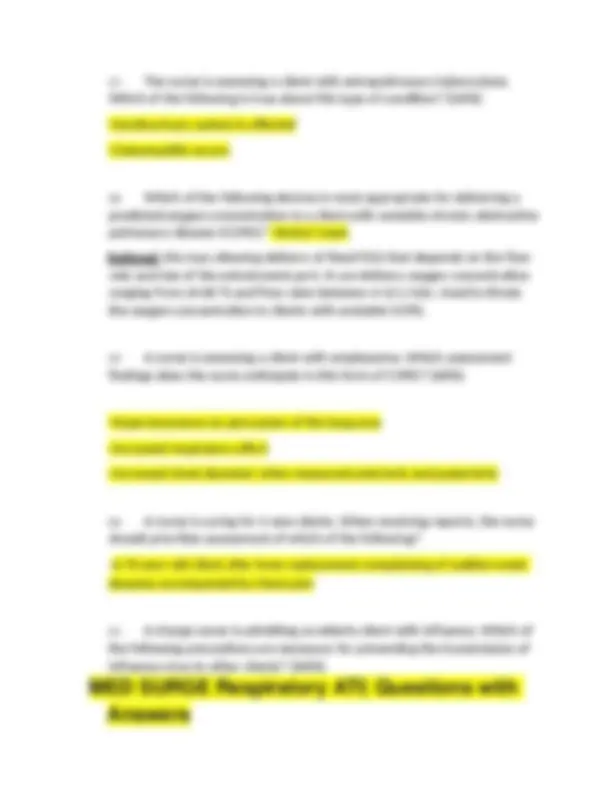
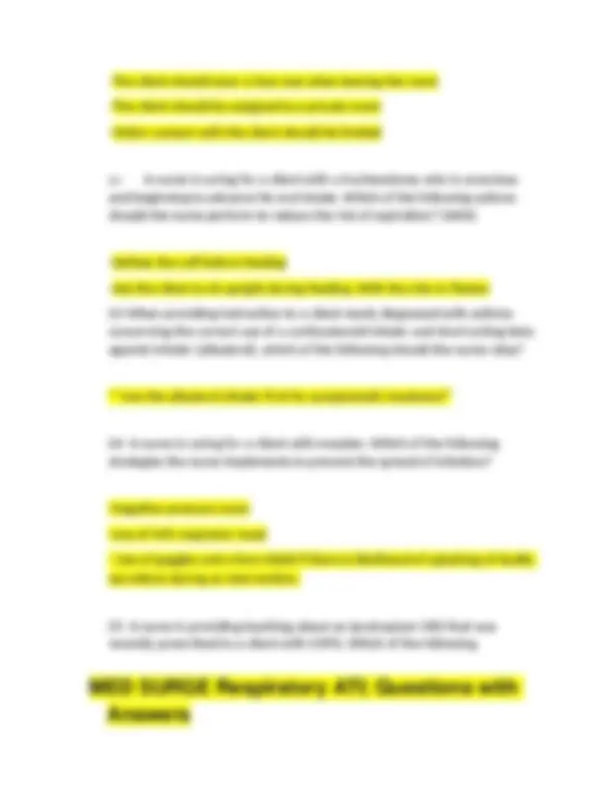
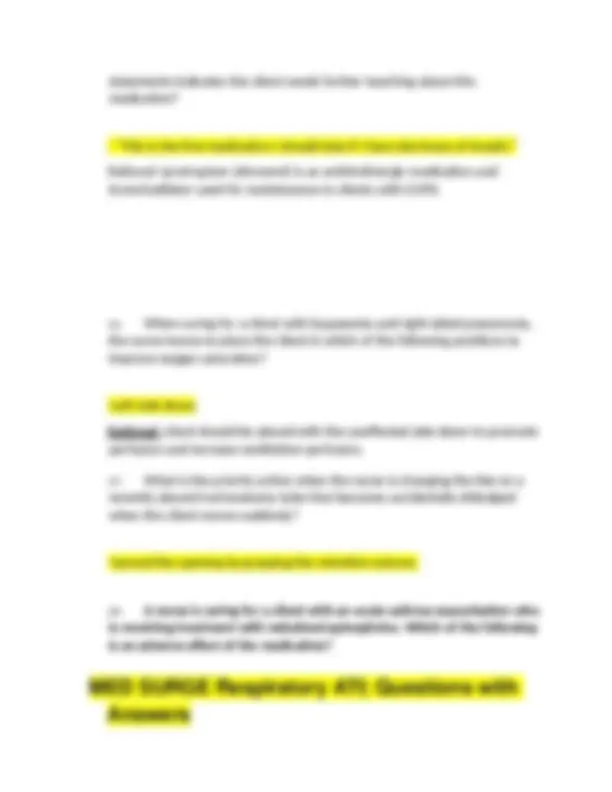
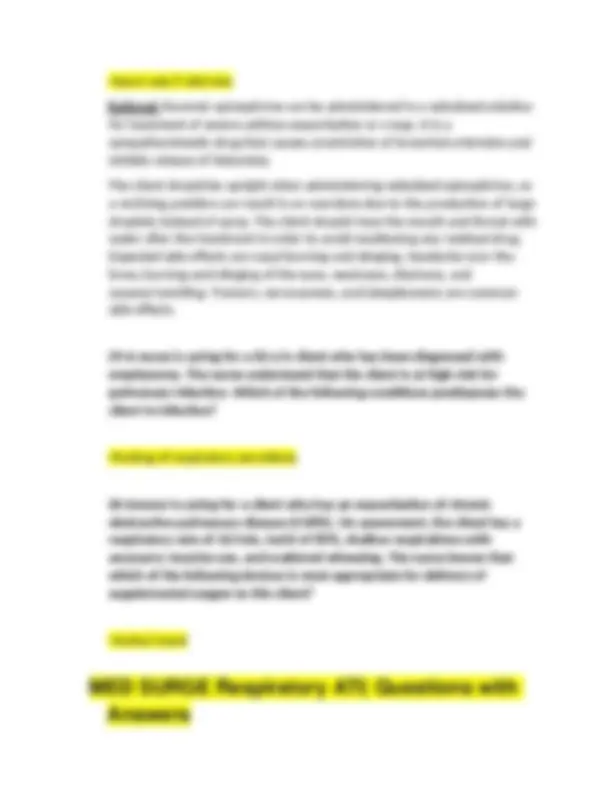
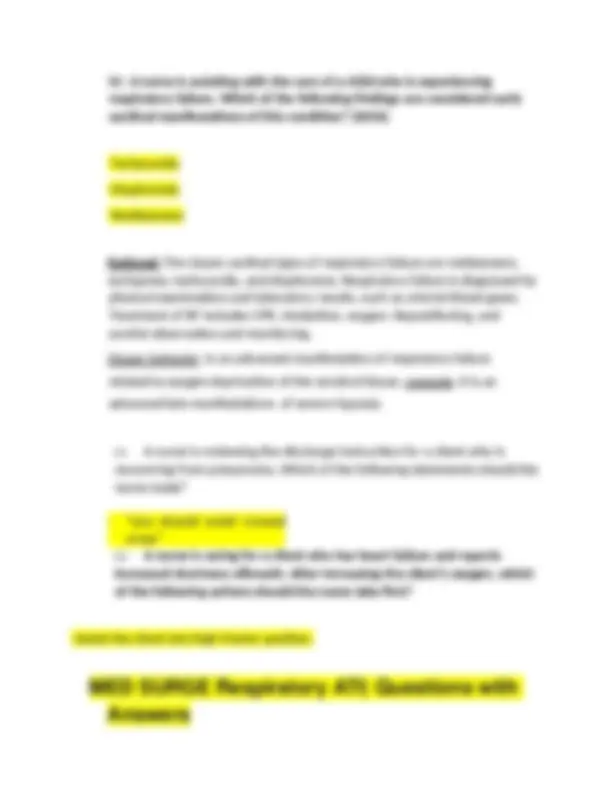
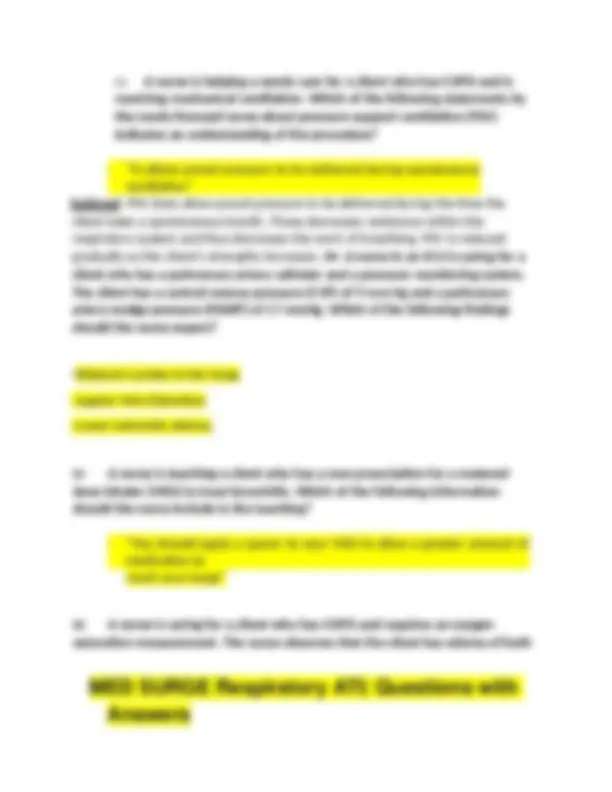
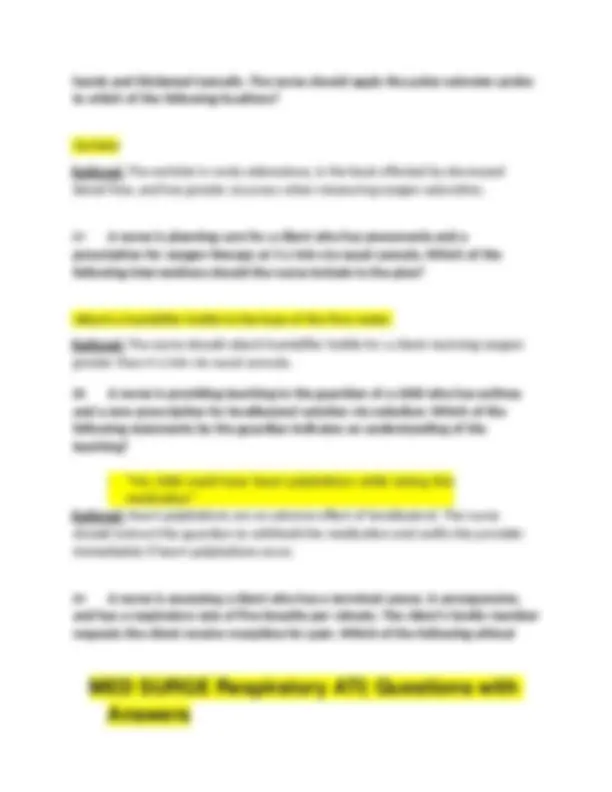
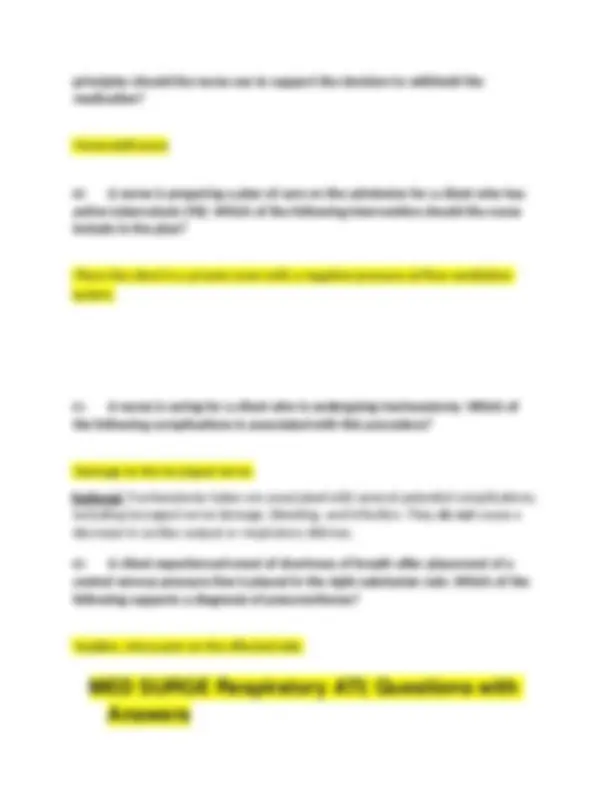
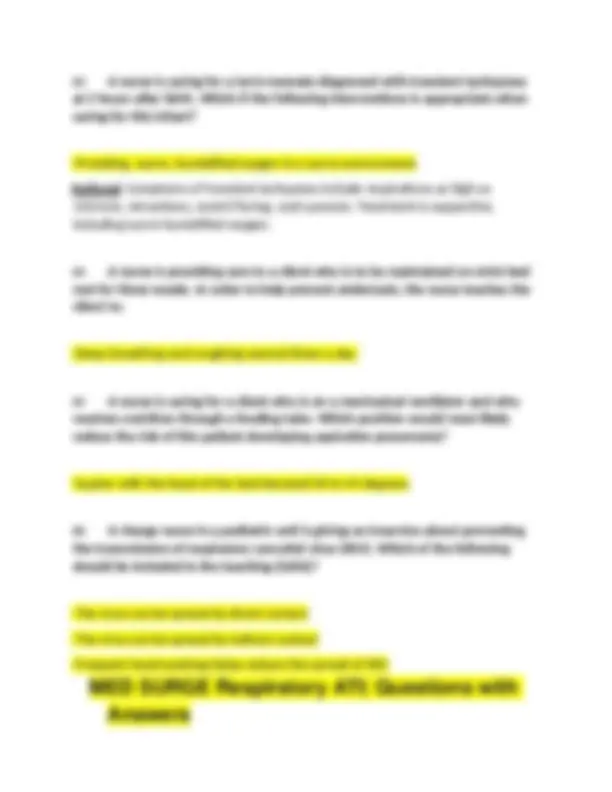
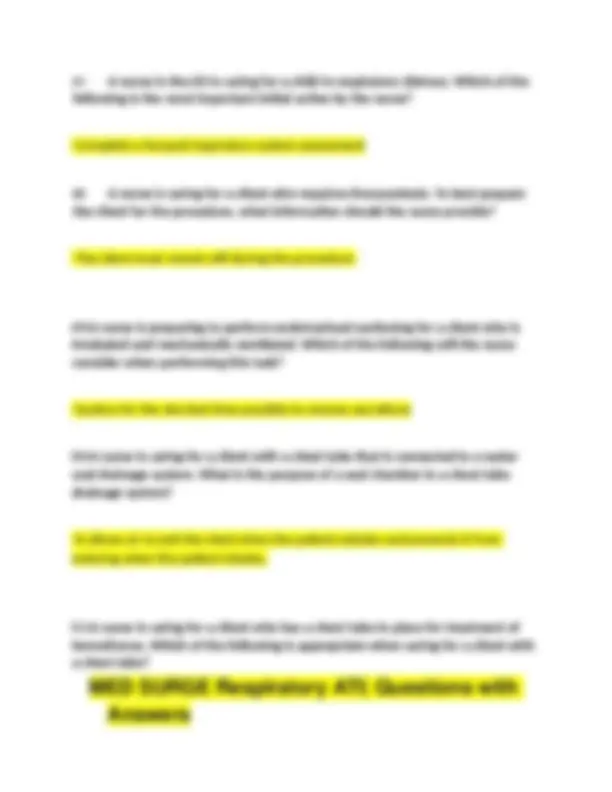
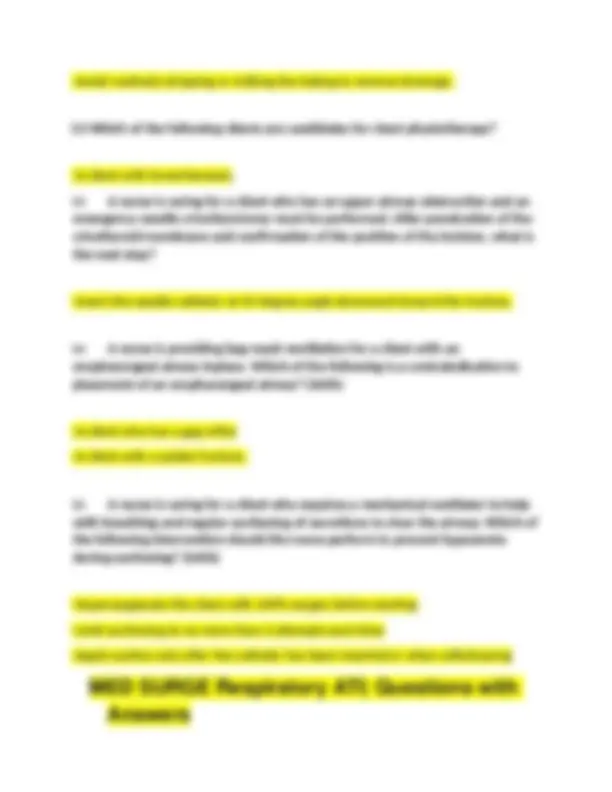
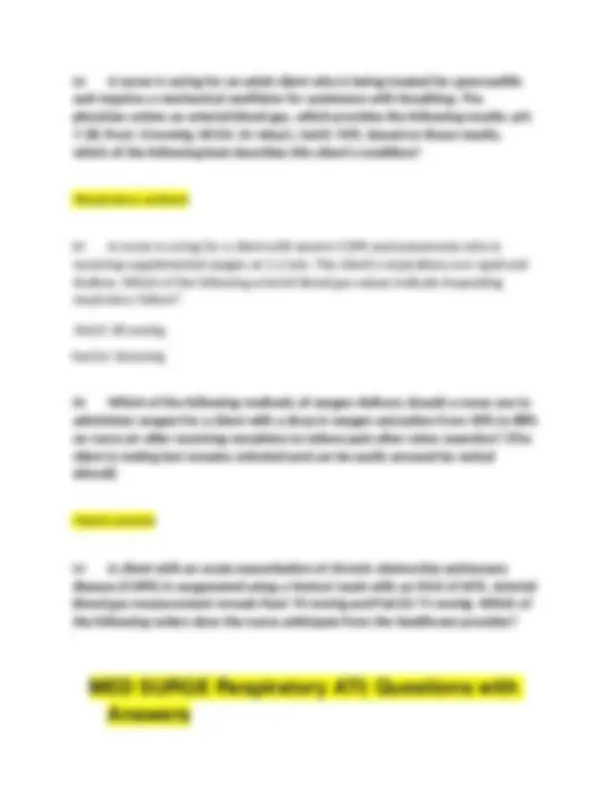
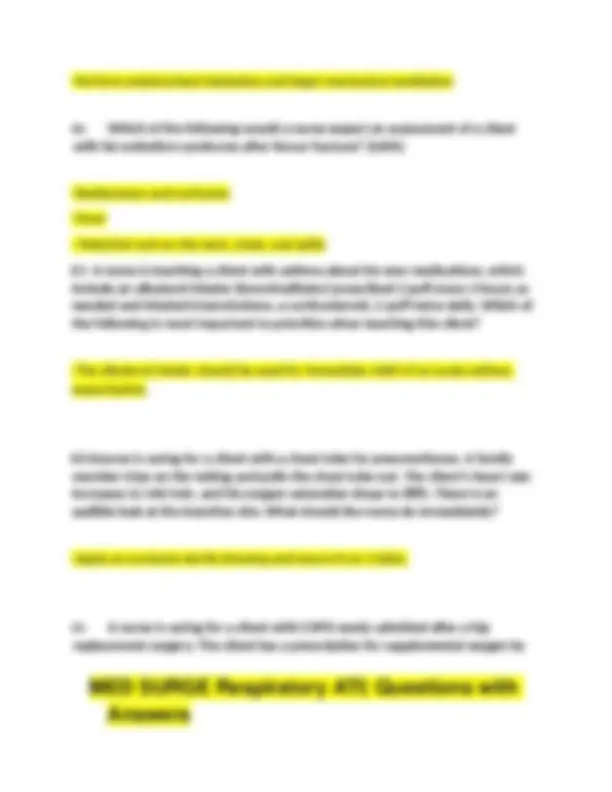
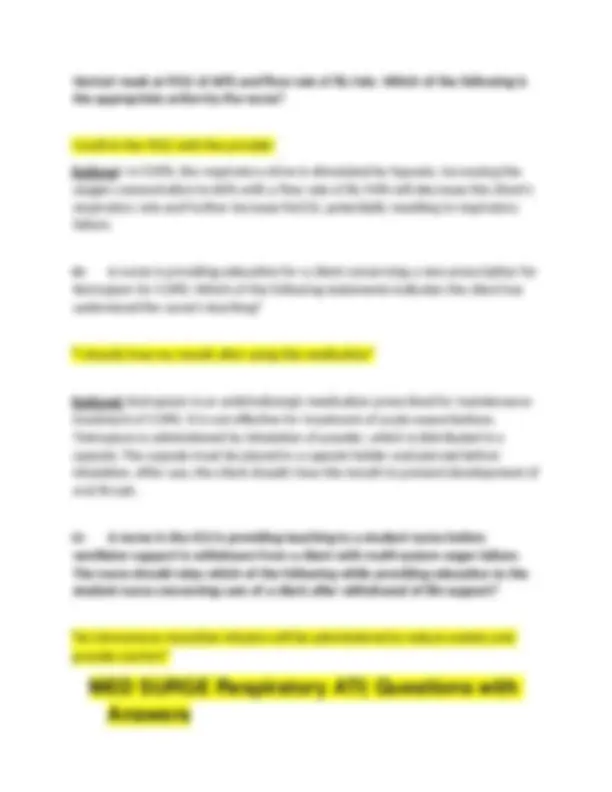
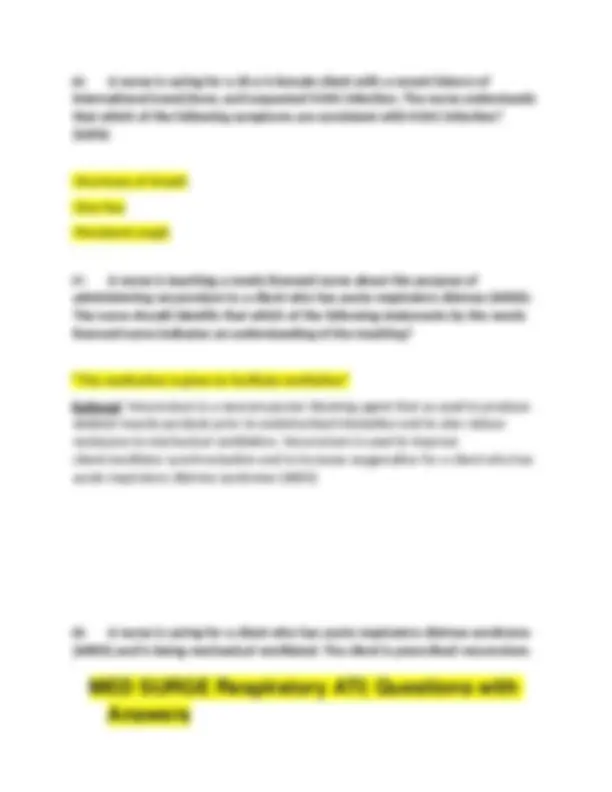
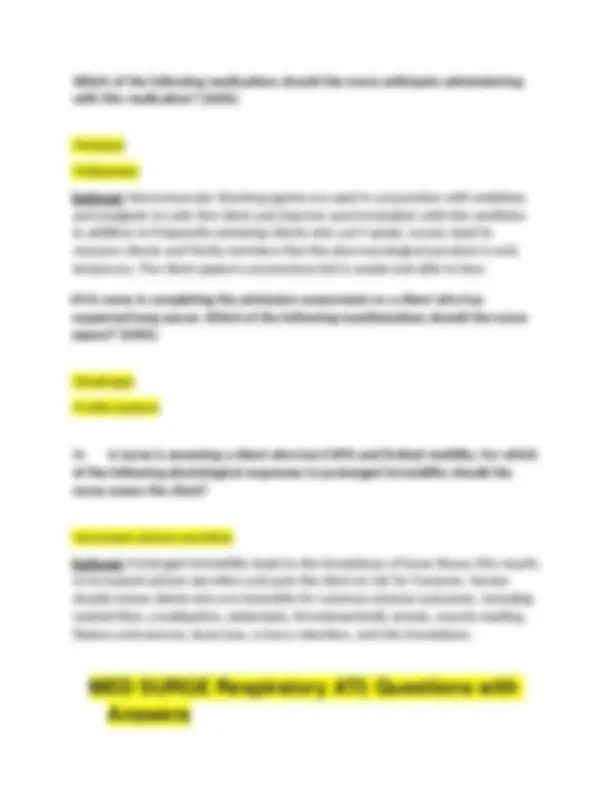
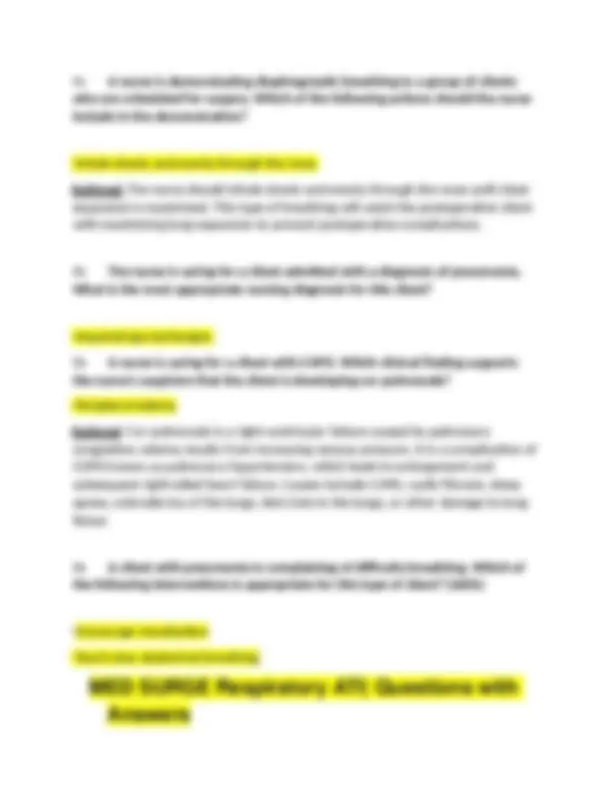
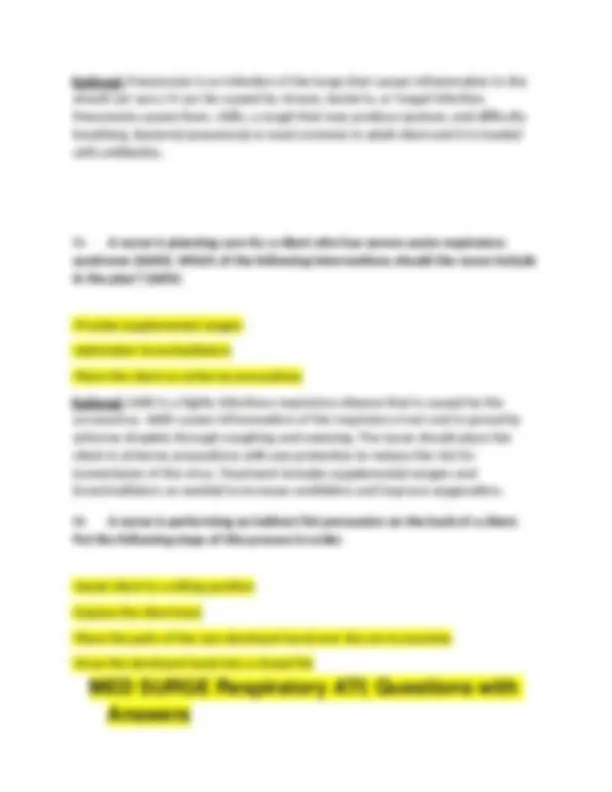
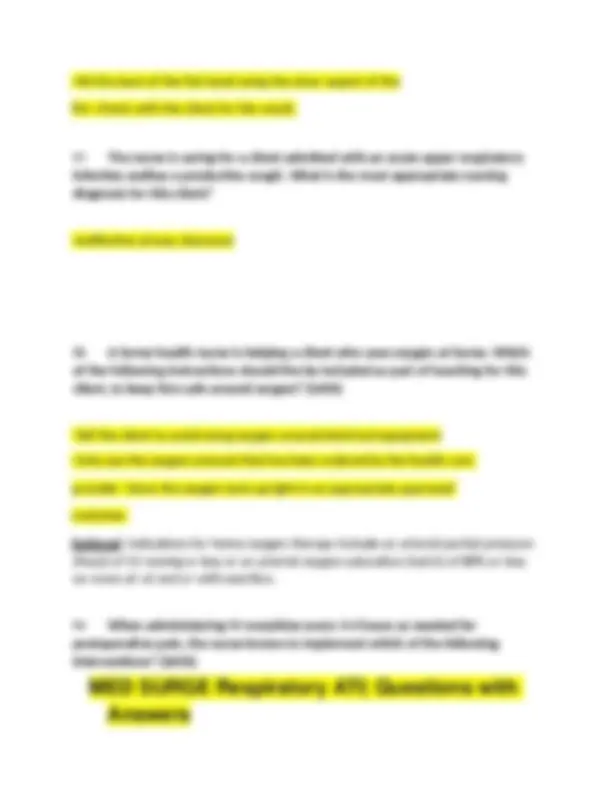
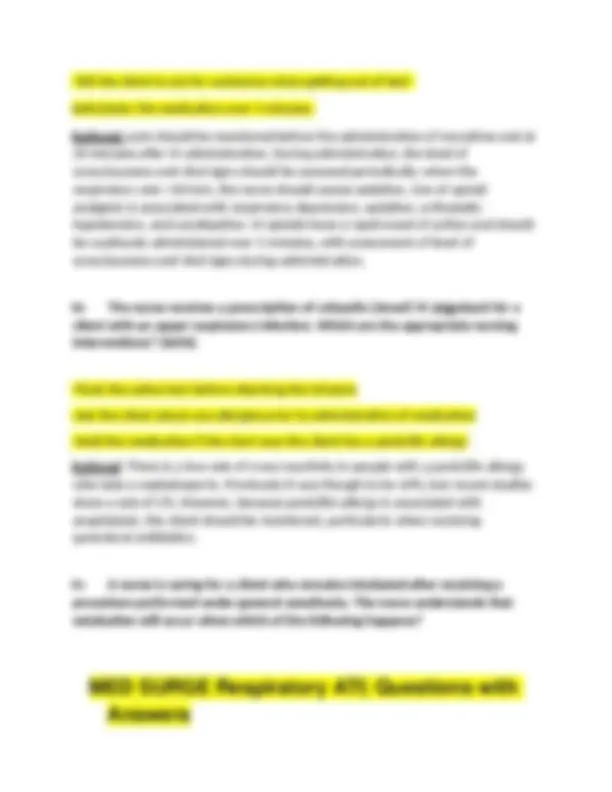
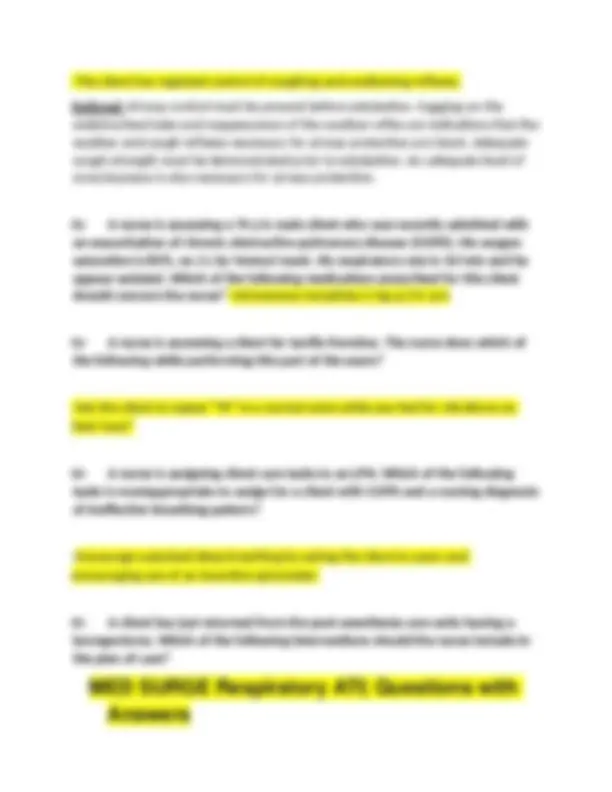
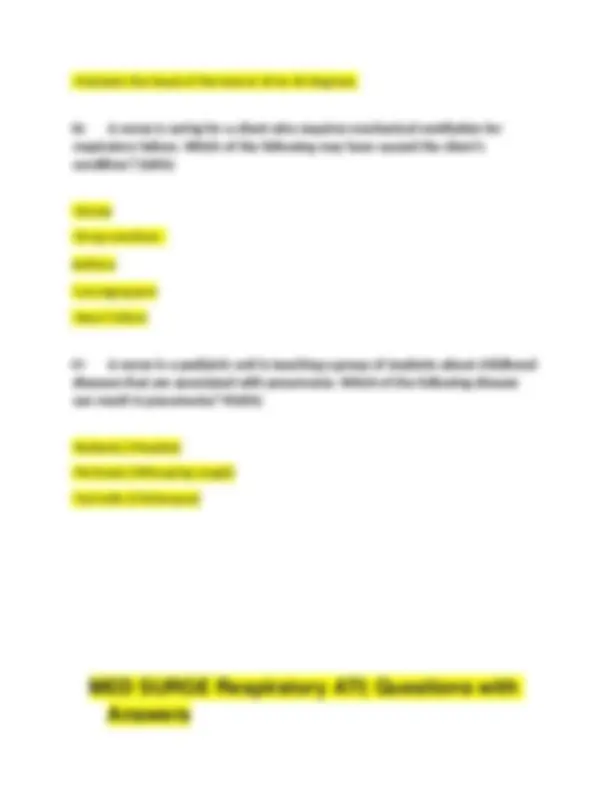


Study with the several resources on Docsity

Earn points by helping other students or get them with a premium plan


Prepare for your exams
Study with the several resources on Docsity

Earn points to download
Earn points by helping other students or get them with a premium plan
Community
Ask the community for help and clear up your study doubts
Discover the best universities in your country according to Docsity users
Free resources
Download our free guides on studying techniques, anxiety management strategies, and thesis advice from Docsity tutors
MED Surge Respiratory ATI Exam Questions with Answers 1- A charge nurse receives notification of the admission of a client who is coughing frequently and whose sputum is pink, frothy, and copious. The client has history of night sweats, anorexia, and weight loss. Which of the following actions should the nurse take? (SATA) -Assign the client to a private room with negative-pressure airflow -Wear an N95 respirator when entering the client’s room. 2- A nurse is assisting a provider with a comprehensive physical examination of a client. When the provider uses transillumination, the nurse should explain to the client that this technique help evaluate which of the following structures? -Maxillary sinuses 3- A nurse is caring for a client who smokes cigarettes and has a new diagnosis of emphysema. How should the nurse assist the client with smoking cessation? -Discuss ways the client can reduce the number of cigarettes smoked per day.
Typology: Exams
1 / 40

This page cannot be seen from the preview
Don't miss anything!

































1- A charge nurse receives notification of the admission of a client who is coughing frequently and whose sputum is pink, frothy, and copious. The client has history of night sweats, anorexia, and weight loss. Which of the following actions should the nurse take? (SATA) -Assign the client to a private room with negative- pressure airflow -Wear an N95 respirator when entering the client’s room. 2- A nurse is assisting a provider with a comprehensive physical examination of a client. When the provider uses transillumination, the nurse should explain to the client that this technique help evaluate which of the following structures? -Maxillary sinuses 3- A nurse is caring for a client who smokes cigarettes and has a new diagnosis of emphysema. How should the nurse assist the client with smoking cessation? -Discuss ways the client can reduce the number of cigarettes smoked per day. 4- A nurse is planning care for a client who has chronic obstructive pulmonary disease (COPD) and is malnourished. Which of the following recommendations to promote nutritional intake should the nurse include in the plan?
-Eat high-calorie food first. Rational: client who has COPD experience early satiety. Client should eat calorie- dense food first. 5- A nurse is preparing to administer cisplatin IV to a client who has lung cancer. The nurse should identify that which of the following findings is an adverse effect of this medication? -Tinnitus. Rational: An adverse effect of cisplatin is ototoxicity, which can cause tinnitus. 6- A nurse in a medical-surgical unit is assessing a client. The nurse should identify that which of the following findings is a manifestation of a pulmonary embolism? -Stabbing chest pain Rational : sudden chest pain that is sharp and stabbing is a manifestation of pulmonary embolism. Other manifestations include dyspnea, coughing, hemoptysis (coughing up blood), tachypnea, tachycardia, diaphoresis, and feeling of impending doom. 7- A nurse in the PACU is assessing a newly admitted client and observes intercostal retractions and a high-pitched inspiratory sound (stridor). The nurse should identify theses findings as manifestations of which of the following complications? -Respiratory obstruction 8- A nurse is reviewing the laboratory results of a client who has metabolic alkalosis. Which of the following laboratory values should the nurse expect?
-“The lower tube will drain blood, and the higher tube will remove air.” 13- A nurse is providing teaching to a client who will undergo a total laryngectomy. Which of the following statements indicate that the client understands the impact of the surgery?
-NPO status -Alternative methods of communication - Changes in body image -Swallowing exercises. 17- A nurse in a clinic is providing teaching for a client who is scheduled to have a tuberculin skin test. Which of the following pieces of information should the nurse include?
26-A nurse is caring for a client following a right pleural thoracentesis. The nurse measures a total of 35 ml of purulent drainage. Which of the following findings should the nurse recognize as an indication of tension pneumothorax? (SATA) -Tracheal deviation to the left -Absent breath sounds on the right side -Neck vein distention 27-A nurse is providing discharge teaching to a client who has emphysema. Which of the following instructions should the nurse include? -“Try to drink at least 2 to 3 liters of fluid per day” Rational : clients who have emphysema should drink 2 to 3 L per day to help liquefy secretions. 28-A nurse is caring for a client who had a left lower lobectomy to treat lung cancer. Which of the following factors will have a significant impact on the plan of care for this client? -Lung cancer usually has metastasized before the client present with symptoms. 29-A nurse is assessing a client who has a positive tuberculin skin test. Which of the following findings indicates that the client has active tuberculosis? -Night sweats. Rational: manifestations of active tuberculosis include a fever, coughing, night sweats, anorexia, and fatigue.
30-A nurse is providing discharge teaching to a client who had a pulmonary embolism. Which of the following statements indicates that the client understands the information? -“I’ll call the doctor if I see any blood in my urine or stool.” Rational : bleeding precautions are essential to clients who had a pulmonary embolism because they taken an anticoagulant. They should report any signs of bleeding immediately. 31-A nurse is caring for a client whom the respiratory therapist has just removed the endotracheal tube. Which of the following actions should the nurse take first? -Evaluate the client for stridor 32-A nurse in a provider’s office is assessing a client who states he was recently exposed to tuberculosis. Which of the following findings is a clinical manifestation of pulmonary tuberculosis? -Night sweats 33-A nurse on a medical-surgical unit is caring for a client who is postoperative following a hip replacement surgery. The client reports feeling apprehensive and restless. Which of the following findings should the nurse recognize as an indication of pulmonary embolism? -Sudden onset of dyspnea. Rationa l: clinical manifestations of pulmonary embolism have a rapid onset. Dyspnea occurs duet o reduced blood flow to the lungs. 34-A client is admitted to the emergency department following a motorcycle crash. The nurse notes a crackling sensation upon palpation of the right side of the client’s chest. After notifying the provider, the nurse document this finding as which of the following?
Rational : dry cough is a clinical manifestation of the prodromal stage of inhalation anthrax. During this stage, it is difficult to distinguish the condition from influenza or pneumonia because there is no sore throat or rhinitis. 38-A nurse is caring for a client who has a tracheostomy with an inflated cuff in place. Which of the following findings indicates that the nurse should suction the client airway secretions? -The nurse auscultates coarse crackles in the lung fields. 39-A nurse is planning care for a client following placement of a chest tube 1 hr ago. Which of the following actions should the nurse include in the plan of care? -Tape all connections between the chest tube and drainage system. Rational: the nurse should tape all connections to ensure that the system is airtight and prevent the chest tubing from accidentally disconnecting. 40-A nurse in the emergency department is assessing a client for closed pneumothorax and significant bruising of the left chest following a motor- vehicle crash. The client reports severe left chest pain on inspiration. The nurse should assess the client for which of the following manifestations of pneumothorax? -Absence of breath sounds 41-A nurse is providing discharge teaching about improving gas exchange for client who has emphysema. Which of the following instructions should the nurse include in the teaching? -Use pursed-lip breathing during periods of dyspnea.
Rational : using pursed-lip breathing during periods of dyspnea will slow expiration, increase airway pressure, and facilitate effective gas exchange. 42-A nurse is caring for a client who is scheduled to have his chest tube removed. Which of the following actions the nurse takes?
-Draining blood and fluid from the pleural space. 52- A nurse is caring for a client who has a 20-year history of COPD and is receiving oxygen at 2 L/min via nasal canula. The client is dyspneic and has an oxygen saturation via pulse oximetry of 85%. Which of the following actions should the nurse take? -Increase the oxygen flow and request an arterial blood gas determination. Rational: the client requires oxygen at a rate that will keep the oxygen saturation between 88% and 92%. The nurse should increase the client’s oxygen and evaluate its effectiveness with ABG results and oxygen saturation via pulse oximetry measurements. 53- A nurse is teaching breathing techniques to a client who has emphysema. Which of the following statements indicates that the client understands the mechanics of pursed-lip breathing?
4- A nurse in the emergency department is assessing a client admitted to the emergency department who has sustained crushing chest injuries in a car accident. Which of the following signs indicate a possible pneumothorax? -Diminished or absent breath sounds on the affected side 5- A client who had extensive pelvic surgery 24 hr ago becomes cyanotic, is gasping for breath, and complains of right-sided chest pain. What should the nurse do first? -Administer oxygen using a face mask 6- A client is admitted with second degree burns on face, neck, anterior chest, and hands. The nurse’s priority action would be: -Assess for dyspnea and stridor 7- A client who underwent a left lower lobectomy is forty-eight hrs post op. The client is receiving morphine sulfate via a patient-controlled analgesia (PCA) system and report having pain in the left thorax that worsens coughing. The nurse should: -Obtain a more detailed assessment of the client’s pain using a pain scale. 8- A nurse is caring for a client who is undergoing tracheostomy. The nurse understands that which of the following is a complication of this procedure? -Damage to the recurrent laryngeal nerve. 9- A nurse is assessing a client’s arterial blood results. The results are pH 7.50, bicarbonate 32mEq/L, and PaCO2 36 mmHg. Which of the following do these arterial gas results indicate? -Metabolic alkalosis
10-A nurse is caring for a client on a ventilator who has ventilator settings with a preset tidal volume. Which best describes the tidal volume (VT) in this setting: -The amount of air inhaled with each breath 11-The nurse is caring for a client who has just been intubated for respiratory failure. The physician orders the ventilator to be set SIMV mode. Which best describes SIMV? -A preset number of breaths delivered to the client at certain volume 12-A client with asthma is scheduled for treatment with methylxanthine for nocturnal wheezing. Which of the following drugs are methylxanthine drugs that are appropriate for the treatment of this client? (SATA) -Theophylline -Aminophylline 13-The nurse is administering cromolyn sodium (Intal) for client with asthma. Which of the following are true about this drug? (SATA) -It causes headache -It prevents an attack 14-A nurse caring for a client with hemothorax. The physician plans to insert a right-sided chest tube. ( La pregunta pide ordenar los cuadritos en el orden correcto)
17- The nurse is assessing a client with extrapulmonary tuberculosis. Which of the following is true about this type of condition? (SATA) -Genitourinary system is affected -Osteomyelitis occurs 18- Which of the following devices is most appropriate for delivering a predicted oxygen concentration in a client with unstable chronic obstructive pulmonary disease (COPD)? -Venturi mask Rational: this mas allowing delivery of fixed FiO2 that depends on the flow rate and size of the entrainment port. It can delivery oxygen concentration ranging from 24-60 % and flow rates between 4-12 L/min. Used to titrate the oxygen concentration in clients with unstable COPD. 19- A nurse is assessing a client with emphysema. Which assessment findings does the nurse anticipate in this form of COPD? (SATA) -Hyperresonance on percussion of the lung area -Increased respiratory effort -Increased chest diameter when measured anteriorly and posteriorly 20- A nurse is caring for 4 new clients. When receiving reports, the nurse should prioritize assessment of which of the following?